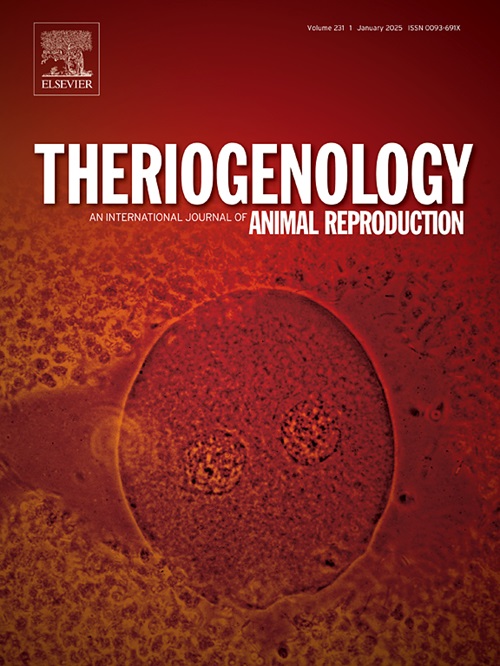Improved reproductive performance and economic outcomes from use of a modified 5-day Cosynch program in pasture-based dairy heifers
IF 2.4
2区 农林科学
Q3 REPRODUCTIVE BIOLOGY
引用次数: 0
Abstract
The primary objective of this study was to evaluate reproductive performance in dairy heifers submitted to fixed-time artificial insemination (FTAI) following a modified 5-day Cosynch program (m5dC) compared to a 7-day Cosynch program (7dC). Additionally, the study examined the economic impacts of treating heifers with the m5dC program compared to the 7dC program, and the effect of pre-synchronization with prostaglandin (PG) on serum progesterone (P4) concentration.
At the start of the breeding season, maiden heifers (n = 565) from four New Zealand dairy farms were randomly allocated to one of two synchronization programs: 1) m5dC (n = 283), 500 μg cloprostenol administered on Study Day −10, 100 μg gonadotrophin-releasing hormone (GnRH) on Study Day −8, 500 μg cloprostenol on Study Day −3, 500 μg cloprostenol on Study Day −2, 100 μg GnRH concurrent with FTAI on Study Day 0, and insertion of an intravaginal P4-releasing insert (CIDR) for 5 days commencing on Study Day −8; 2) 7dC (n = 282), 100 μg GnRH administered on Study Day −10, 500 μg cloprostenol on Study Day −3, 100 μg GnRH concurrent with FTAI on Study Day −1 and insertion of a CIDR for 7 days commencing on Study Day −10. Heifers were then mated either by a combination of insemination to observed heat and natural mating or by natural mating alone, depending on farm management policy, for a total mating period of up to 10 weeks.
Serum P4 concentration was measured in a subset of heifers (n = 34) selected randomly from both treatment groups at the time of CIDR insertion; geometric mean values were lower for m5dC heifers (1.35 ng/ml (95 % CI 1.04–1.76)) than 7dC heifers (2.95 ng/ml (95 % CI 1.79–4.84)). Conception rate (CR) to FTAI and subsequent reproductive performance were evaluated based on ultrasound pregnancy diagnosis carried out between Study Days 95 and 123. Performance was significantly improved for m5dC heifers compared to 7dC heifers for both CR to FTAI (62.0 % vs. 45.4 %, p = 0.0007) and 6-week pregnancy rate (87.6 % vs. 74.4 %, p = 0.0002). Mean interval from FTAI to conception was shorter for m5dC heifers (15.1 days) compared to 7dC heifers (25.0 days). A difference in final pregnancy rate was not detected between treatment groups (p = 0.18). A partial budget was constructed to estimate the economic return of synchronizing heifers with the m5dC program compared to the 7dC program, producing a net return of NZ$72.29 per heifer. Synchronization of dairy heifers with an m5dC program resulted in superior reproductive performance at FTAI and following 6 weeks of mating compared to the 7dC program.
改良的5天Cosynch计划在放牧型奶牛中提高了繁殖性能和经济效益
本研究的主要目的是评估接受固定时间人工授精(FTAI)的奶牛在改良的5天人工授精计划(m5dC)和7天人工授精计划(7dC)后的生殖性能。此外,本研究还比较了m5dC方案与7dC方案对犊牛的经济影响,以及前列腺素(PG)预同步对犊牛血清孕酮(P4)浓度的影响。在繁殖季节开始时,来自四个新西兰奶牛场的处女小母牛(n = 565)被随机分配到两个同步计划中的一个:1) m5dC (n = 283),在研究第10天给予500 μg氯前列醇,在研究第8天给予100 μg促性腺激素释放激素(GnRH),在研究第8天给予500 μg氯前列醇,在研究第8天给予3500 μg氯前列醇,在研究第2天给予500 μg氯前列醇,在研究第0天同时给予100 μg GnRH和FTAI,从研究第8天开始,连续5天插入阴道内p4释放剂(CIDR);2) 7dC (n = 282),在研究日- 10给予100 μg GnRH,在研究日- 3给予500 μg氯前列醇,在研究日- 1同时给予100 μg GnRH和FTAI,从研究日- 10开始插入CIDR,为期7天。然后,根据农场管理政策,通过人工授精观察热度和自然交配的结合或仅通过自然交配进行交配,总交配期长达10周。在CIDR插入时,从两个处理组中随机选取一组小母牛(n = 34)测定血清P4浓度;m5dC小母牛的几何平均值(1.35 ng/ml (95% CI 1.04-1.76))低于7dC小母牛(2.95 ng/ml (95% CI 1.79-4.84))。在研究第95天至第123天期间进行超声妊娠诊断,评估受孕率(CR)至FTAI及随后的生殖性能。与7dC母牛相比,m5dC母牛的生产性能在CR / FTAI(62.0%比45.4%,p = 0.0007)和6周妊娠率(87.6%比74.4%,p = 0.0002)方面均有显著提高。m5dC母牛从FTAI到受胎的平均间隔时间(15.1天)比7dC母牛(25.0天)短。两组最终妊娠率差异无统计学意义(p = 0.18)。构建了一个部分预算来估计与m5dC计划同步的小母牛与7dC计划相比的经济回报,每头小母牛的净回报为72.29新西兰元。与7dC计划相比,m5dC计划的奶牛在FTAI和交配后6周的繁殖性能优于7dC计划。
本文章由计算机程序翻译,如有差异,请以英文原文为准。
求助全文
约1分钟内获得全文
求助全文
来源期刊

Theriogenology
农林科学-生殖生物学
CiteScore
5.50
自引率
14.30%
发文量
387
审稿时长
72 days
期刊介绍:
Theriogenology provides an international forum for researchers, clinicians, and industry professionals in animal reproductive biology. This acclaimed journal publishes articles on a wide range of topics in reproductive and developmental biology, of domestic mammal, avian, and aquatic species as well as wild species which are the object of veterinary care in research or conservation programs.
 求助内容:
求助内容: 应助结果提醒方式:
应助结果提醒方式:


